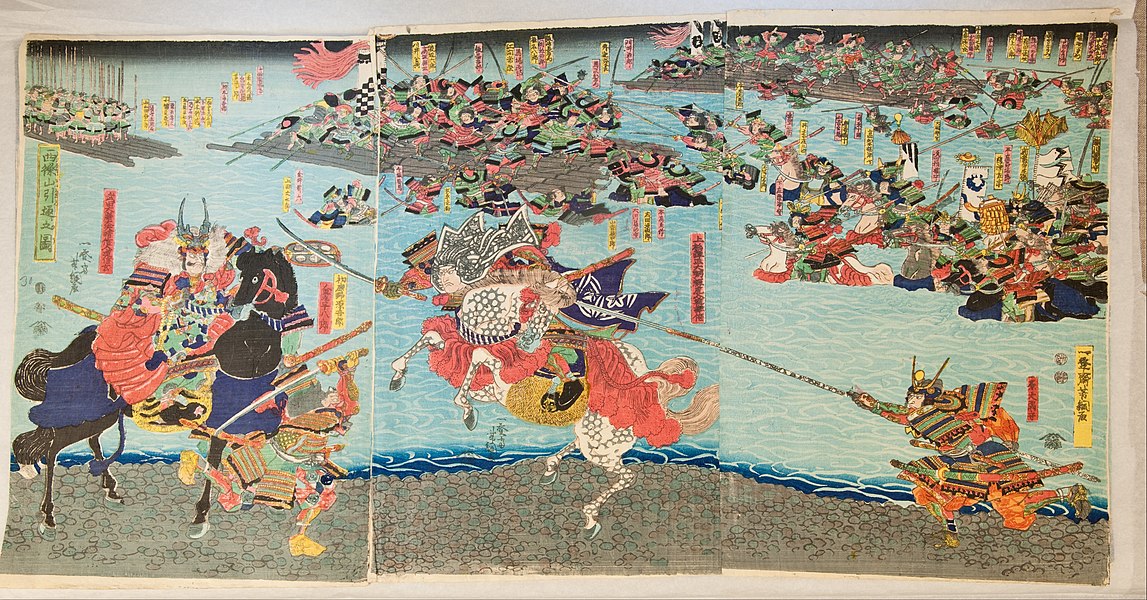 1
1title: Soldiers from the Un'yō attacking the Yeongjong castle on a Korean island.
artist:
Unknown author.date: 1876
medium: Technique woodblock print .
source: Cite book|author=Kōichi Hagiwara|title=図説 西郷隆盛と大久保利通 [Illustrated Life of Saigō Takamori and Okubo Toshimichi]|location=Tokyo|publisher=河出書房新社 [Kawade Shobō Shinsha]|year=2004|isbn=9784309760414
credit: Kōichi Hagiwara () 図説 西郷隆盛と大久保利通 [Illustrated Life of Saigō Takamori and Okubo Toshimichi], Tokyo: 河出書房新社 [Kawade Shobō Shinsha] ISBN: 9784309760414.
description: A depiction of the Ganghwa Island incident, an armed encounter between the Joseon Dynasty of Korea and Japan in the vicinity of Ganghwa Island, showing japanese marines from the japanese gunboat Un'yō">gunboat Un'yō landing on Yeongjong Island on to attack the Yeongjong castle (actually a battery).
license:Public domain
 2
2title: Tsunami by hokusai 19th century
artist: Katsushika Hokusai
date: First publication: between circa 1830 and circa 1832 .
dimensions: size cm 25.7 37.9
current location: Institution:Metropolitan Museum of Art
source: Met online|45434
credit: Metropolitan Museum of Art, online database: entry 45434
license:Public domain
 3
3title: Great Wave off Kanagawa2
artist: After Katsushika Hokusai
date: First publication: between 1826 and 1833 .
This edition: Reprint by Adachi from the Shōwa period (between 1926 and 1989).medium: technique woodblock print color=color
current location: Institution:Library of Congress
source: Restored version of [[:File:Great Wave off Kanagawa.jpg]] (rotated and cropped, dirt, stains, and smudges removed. Creases corrected. Histogram adjusted and color balanced.)
credit: Restored version of File:Great Wave off Kanagawa.jpg (rotated and cropped, dirt, stains, and smudges removed. Creases corrected. Histogram adjusted and color balanced.)
license:Public domain
 4
4title: 1871 (Meiji 4) Woodblock Map of Japan Geographicus - Japan-meiji4-1871
artist: link
date: 1871 (dated)
dimensions: Size unit=in width=24 height=31
source: Geographicus-source
credit: This file was provided to Wikimedia Commons by Geographicus Rare Antique Maps, a specialist dealer in rare maps and other cartography of the 15th, 16th, 17th, 18th and 19th centuries, as part of a cooperation project.
description: This very rare item is a hand colored Meiji Period woodcut map of Japan. Impressive size and detail. Produced in the late 19th century japanese woodcut style, this map is a rare combination of practical and decorative. All text in japanese. A fine example from the Meiji period of japanese cartography and an very rare piece.
license:Public domain
 5
5title: 1839 Woodblock Ino Tadataka Atlas of Japan or Kokugun Zenzu ( 2 volumes ) Geographicus - KokugunZenzu-InoTadatka-1839
artist: link
date: circa 1839 (undated)
dimensions: Size unit=in width=7.75 height=11
source: Geographicus-source
credit: This file was provided to Wikimedia Commons by Geographicus Rare Antique Maps, a specialist dealer in rare maps and other cartography of the 15th, 16th, 17th, 18th and 19th centuries, as part of a cooperation project.
description: Entitled Kokugun Zenzu and printed c. 1839 (Tenpo 10), this is an early japanese atlas of exceptional rarity, beauty and importance. Compiled by Motonobu Aoo and Toshiro Eirakayu based upon the works of Japan's 18th century master cartographer Ino Tadataka, this set of two volumes contains more than 70 regional maps of Japan. Each map offers spectacular beauty and detail exhibits traditional japanese cartography at its finest. Such atlases were compiled by order of the Shogun Tokugawa and given as gifts to his favored warlords. Many of the feudal fortresses in Japan were subsequently destroyed by war and fire, their archives were lost, and thus few such examples survive. Further Ino Tadataka material is additionally rare as most of his surviving maps were assembled in the late 1800s by an imperial functionary and avid Ino collector. They were subsequently stored in the Royal Palace archives which were themselves, tragically, destroyed by fire in 1912. There are two different versions of this atlas. Though both have the same maps, one is a deluxe edition, is larger and printed on heavy paper. The other is printed on very thin paper and is physically thinner. This is the smaller edition.
license:Public domain
 6
6title: 1856 Japanese Edo Period Woodblock Map of Musashi Kuni (Tokyo or Edo Province) Geographicus - MusashiKuni-japanese-1856
artist: link
date: 1856 (dated)
dimensions: Size unit=in width=51 height=44
source: Geographicus-source
credit: This file was provided to Wikimedia Commons by Geographicus Rare Antique Maps, a specialist dealer in rare maps and other cartography of the 15th, 16th, 17th, 18th and 19th centuries, as part of a cooperation project.
description: A large-format Edo Period japanese woodblock map of Musashi Province dating to 1858. Musashi (武蔵国, Musashi no kuni) was a province of Japan, which today comprises Tokyo Prefecture, most of Saitama Prefecture and part of Kanagawa Prefecture, mainly Kawasaki and Yokohama. Musashi bordered on Kai, Kozuke, Sagami, Shimosa, and Shimotsuke Provinces. Musashi was the largest province in the Kanto region. It had its ancient capital in modern Fuchu, Tokyo and its provincial temple in what is now Kokubunji, Tokyo. By the Sengoku period, the main city was Edo, which became the dominant city of eastern Japan. Edo Castle was the headquarters of Tokugawa Ieyasu before the Battle of Sekigahara and became the dominant city of Japan during the Edo period, being renamed Tokyo during the Meiji Restoration. Printed in the traditional japanese style popular during the Edo Period, with topograpy shown in profile, no firm directional orientation, and map titles in cartouches.
license:Public domain
 7
7title: 1847 Japanese Edo Period Woodblock Map of the Izu Islands (Tokyo or Edo) Geographicus - IsuIslands-japanese-1730
artist: link
date: circa 1847 (undated)
dimensions: Size unit=in width=41.5 height=30
source: Geographicus-source
credit: This file was provided to Wikimedia Commons by Geographicus Rare Antique Maps, a specialist dealer in rare maps and other cartography of the 15th, 16th, 17th, 18th and 19th centuries, as part of a cooperation project.
description: An extraordinary find, this is a c. 1847 Tokugawa Period japanese woodblock nautical chart of the Izu Islands (伊豆諸島 Izu-shoto). Oriented to the East, this map covers from Chiba, Kanagawa, and Sagami Bay southwards as far as Miyake and Mikurajima Islands. Traditionally referred to as the Izu Seven (伊豆七島 Izu Shichito?), the Izu Islands are officially part of modern day Tokyo. Though many are uninhabited nature preserves, some of the Ize Islands host large town and villages. This map notes the locations of various shrines, towns, rivers, temples, and identifies local production specialties. With minimal inland detail this map can best be interpreted as a traditional japanese nautical chart. Notes nautical routes and many offshore features including dangerous reefs and shoals. Though undated the latest information on this map dates to 1847 and the whole is stylistically consistent with our advertised date of c. 1847.
license:Public domain
 8
8title: Preparatory Sketch for Woodblock Print Triptych Battle at Sea LACMA AC1995.50.1.1-.3
artist:
Utagawa Yoshitora (Japan, Edo, active circa 1840-1880)date: Late 19th century
current location: Institution:Los Angeles County Museum of Art
source: *Image: link *Gallery: link Wayback|url=http%3A//collections.lacma.org/node/177424|date=20140409211637
credit: Image: link Gallery: link archive copy
description:
- Japan, late 19th century
- Drawings
- Ink on paper, three sheets
- Each sheet: 14 7/8 x 30 5/16 in. (37.7 x 76.9 cm)
- Purchased for the collection by Dr. and Mrs. Richard A. Simms (AC1995.50.1.1-.3)
- japanese-art">japanese Art
license:Public domain
 9
9title: Japanese Woodblock
artist:
Utagawa Yoshitsuna, here signing „Ittōsai Yoshitsuna ga“ (一登斎芳綱画)date: c. 1850
credit: WQFQR7ua1TkMBw at Google Cultural Institute, zoom level maximum
license:Public domain
title: 'Carp Splashing Upstream' by Shibata Zeshin, woodblock, Honolulu Museum of Art, 17107
artist: Shibata Zeshin
source: own
credit: Own work
description: Carp Splashing Upstream by Shibata Zeshin, from the series Album of Works by Shibata Zeshin, woodblock print, Honolulu Museum of Art, accession 17107
license:Public domain






